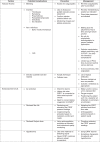Complications Associated with Continuous RRT
- PMID: 36514412
- PMCID: PMC9717642
- DOI: 10.34067/KID.0000792022
Complications Associated with Continuous RRT
Abstract
Continuous renal replacement therapy (CRRT) is a form of renal replacement therapy that is used in modern intensive care units (ICUs) to help manage acute kidney injury (AKI), end stage kidney disease (ESKD), poisonings, and some electrolyte disorders. CRRT has transformed the care of patients in the ICU over the past several decades. In this setting, it is important to recognize CRRT-associated complications but also up-to-date management of these complications. Some of these complications are minor, but others may be more significant and even life-threatening. Some CRRT complications may be related to dialysis factors and others to specific patient factors. Our overarching goal in this article is to review and discuss the most significant CRRT-related complications at the different stage of management of CRRT. With the advent of newer solutions, there have been newer complications as well.
Keywords: CRRT; ICU; acute kidney injury; acute kidney injury and ICU nephrology; bleeding; circuit; complications; dialysis; drugs; electrolytes; pneumothorax.
Copyright © 2022 by the American Society of Nephrology.
Conflict of interest statement
S.C. Gautam reports ownership interest in BNGO, Criper, Invitae (stockholder), Sensonics, and Pacific Biosciences. B.G. Jaar reports honoraria from the American Board of Internal Medicine—Nephrology; patents or royalties from UpToDate; and an advisory or leadership role for the American Board of Internal Medicine, BMC Medicine, BMC Nephrology, the Clinical Journal of the American Society of Nephrology, and the National Kidney Foundation. The remaining author has nothing to disclose.
Figures






References
-
- Parienti JJ, Thirion M, Mégarbane B, Souweine B, Ouchikhe A, Polito A, Forel JM, Marqué S, Misset B, Airapetian N, Daurel C, Mira JP, Ramakers M, du Cheyron D, Le Coutour X, Daubin C, Charbonneau P; Members of the Cathedia Study Group : Femoral vs jugular venous catheterization and risk of nosocomial events in adults requiring acute renal replacement therapy: A randomized controlled trial. JAMA 299: 2413–2422, 2008. 10.1001/jama.299.20.2413 - DOI - PubMed
Publication types
MeSH terms
LinkOut - more resources
Full Text Sources
Miscellaneous

